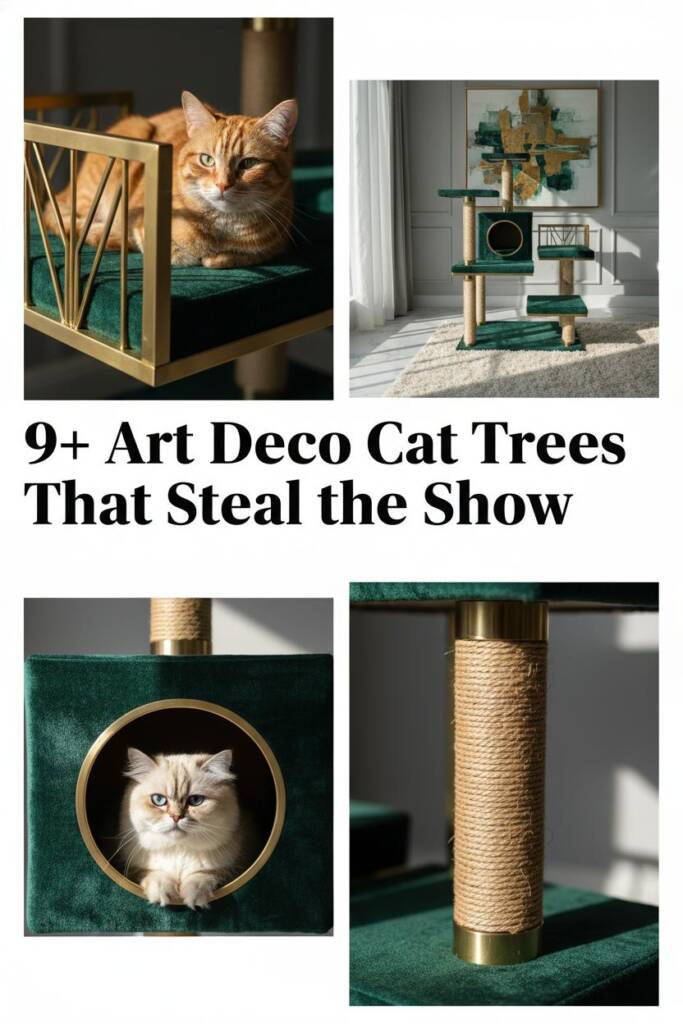
If you’ve ever dreamed of living in a 1920s penthouse with champagne towers and geometric mirrors, why should your cat settle for anything less? Art Deco cat furniture brings the opulence of the Jazz Age into your modern home—think velvet lounges, brass accents, and jewel-toned luxury that would make even the Great Gatsby jealous.
The best part? These stunning pieces don’t just look like museum-worthy sculptures; they’re designed with your cat’s climbing, scratching, and lounging instincts in mind. This isn’t about choosing between style and function anymore—it’s about elevating both to an entirely new level of sophistication.
Why Art Deco Cat Furniture is Having a Major Moment
Art Deco has roared back into interior design, and cat furniture is finally catching up. The style’s signature elements—bold geometric patterns, luxurious materials like velvet and brass, and rich jewel tones—create pieces that demand attention in all the right ways. Unlike traditional cat trees that you hide in the corner, Art Deco designs become the focal point of your room.
The sharp lines and metallic finishes photograph beautifully (hello, Pinterest!), while the plush velvet textures satisfy your cat’s need for comfort and territory marking. Interior designers are increasingly recognizing that pet furniture should enhance a room’s aesthetic, not detract from it.
Art Deco’s inherent drama and elegance make it perfect for pet parents who refuse to compromise their design vision. Plus, the vertical emphasis of many Art Deco silhouettes naturally suits cats’ climbing behavior, creating tall, sculptural pieces that work double duty as functional cat trees and statement furniture.
1. The Emerald Velvet Tower with Brass Geometric Accents
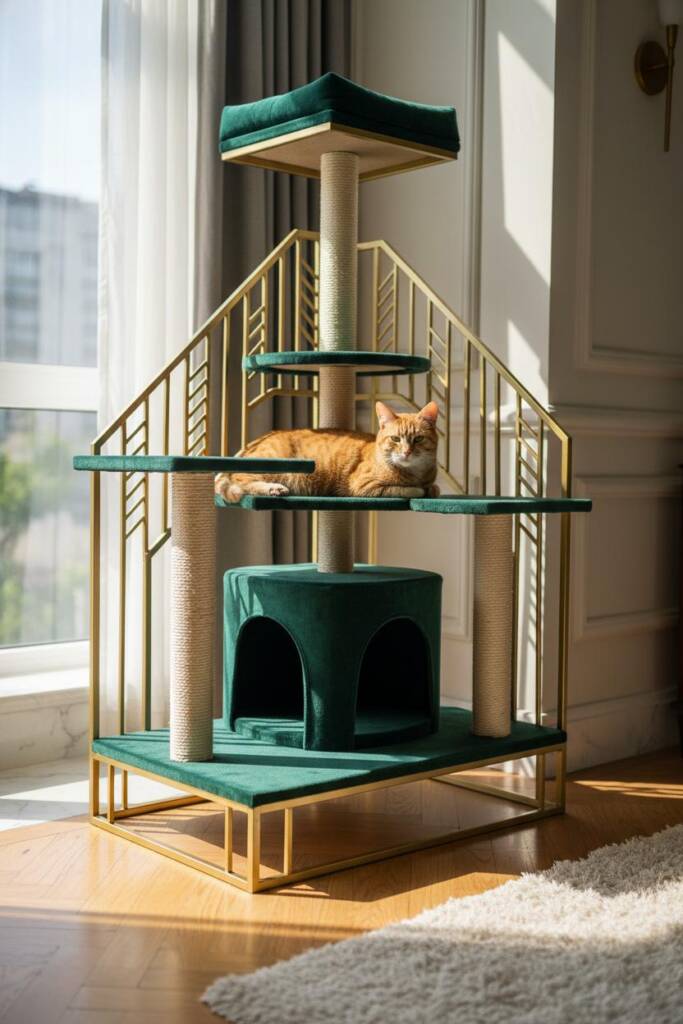
Imagine a cat tree wrapped entirely in deep emerald green velvet, with brass-framed platforms arranged in striking angular patterns. This design takes inspiration from Art Deco skyscrapers, where each level features geometric brass railings that catch the light throughout the day.
The emerald velvet isn’t just gorgeous—it’s also the perfect texture for cats who love to knead and mark their territory, while the brass framework provides sturdy climbing posts that double as scratching surfaces. The color combination of emerald and gold instantly elevates any room, working beautifully with both warm wood tones and cool contemporary palettes.
Your cat gets multiple perching levels at varying heights, satisfying their instinct to survey their domain from above, while you get a piece that looks like it belongs in a luxury hotel lobby. The brass geometric shapes create interesting negative space that adds architectural interest even when your cat isn’t using it. This is the kind of cat tree where guests genuinely ask, “Wait, that’s for your cat?”
2. Sapphire Blue Stepped Pyramid Cat Condo
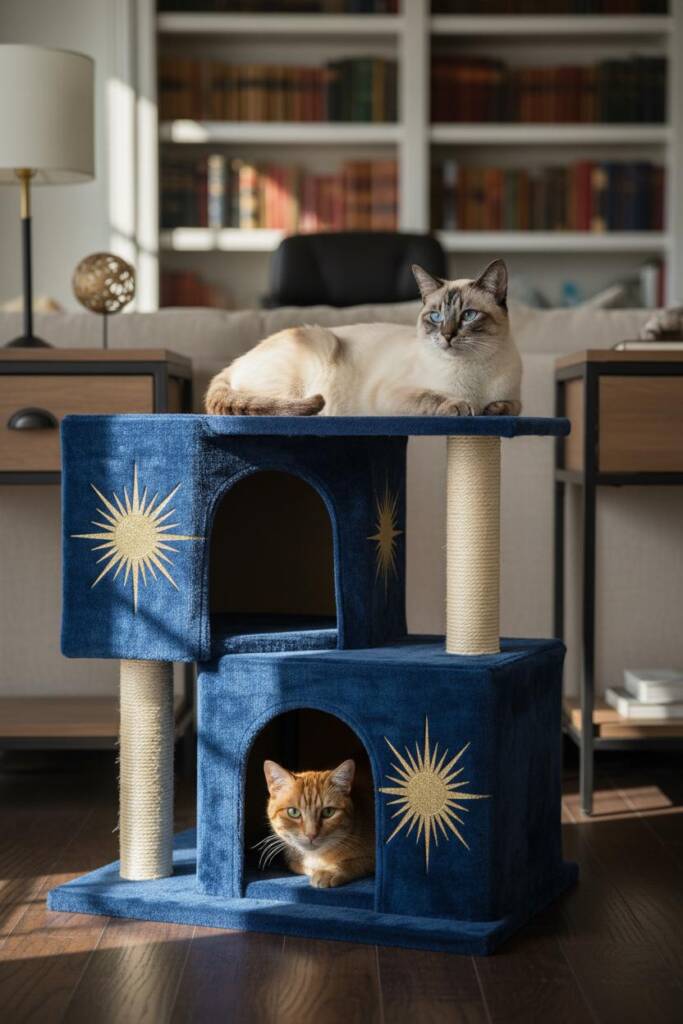
Channel ancient glamour meets Art Deco sophistication with a ziggurat-inspired cat condo in rich sapphire blue velvet. This stepped pyramid design features three or four ascending levels, each adorned with gold sunburst medallions that radiate from the center—a quintessential Art Deco motif that brings instant drama.
The pyramidal structure isn’t just visually striking; it creates natural hideaway caves at each level where shy cats can retreat, while confident cats can lounge on the flat tops. Navy blue velvet provides a sophisticated masculine energy that works exceptionally well in home offices, libraries, or bedrooms, and it won’t show every stray fur the way lighter colors do.
The gold sunburst details can be achieved through embossed fabric panels or metal appliqués, creating texture that catches light from different angles throughout the day. What makes this design particularly clever is how the stepped formation allows cats to leap from level to level easily, accommodating both kittens and senior cats who prefer gentler climbing. It’s substantial enough to feel stable for larger cats, yet the geometric form keeps it from feeling bulky in your space.
3. Black and Gold Skyscraper Cat Tree
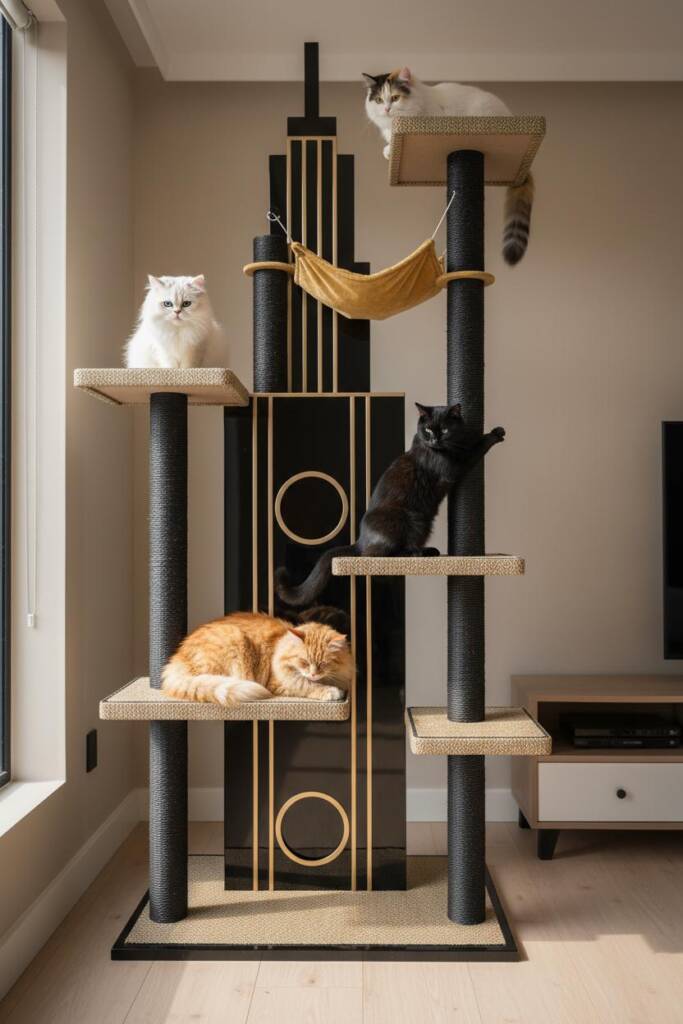
For the ultimate in urban sophistication, a vertical cat tree inspired by 1920s Manhattan skyscrapers brings Chrysler Building energy into your living room. Picture glossy black lacquered posts rising dramatically from floor to ceiling, punctuated by gold leaf or metallic gold platforms at strategic intervals.
This design embraces verticality—perfect for small apartments where floor space is precious but ceiling height is abundant. The sleek black finish with gold accents creates a masculine, gallery-like aesthetic that appeals to minimalist design lovers who want their cat furniture to make an intentional statement. The platforms can feature subtle Art Deco detailing like stepped edges or chevron patterns etched into the surface. Black lacquer has a practical advantage too: it’s incredibly easy to wipe clean and maintain that high-gloss finish.
The narrow footprint means you can tuck this skyscraper into a corner, against a wall, or even use it as a room divider. Your cat benefits from serious vertical territory—the kind that satisfies their evolutionary need to climb high and observe—while the tower’s architectural presence transforms it into functional art. Consider adding small gold-framed “windows” at each level to complete the skyscraper illusion.
4. Mirrored Hexagon Cat Shelf System
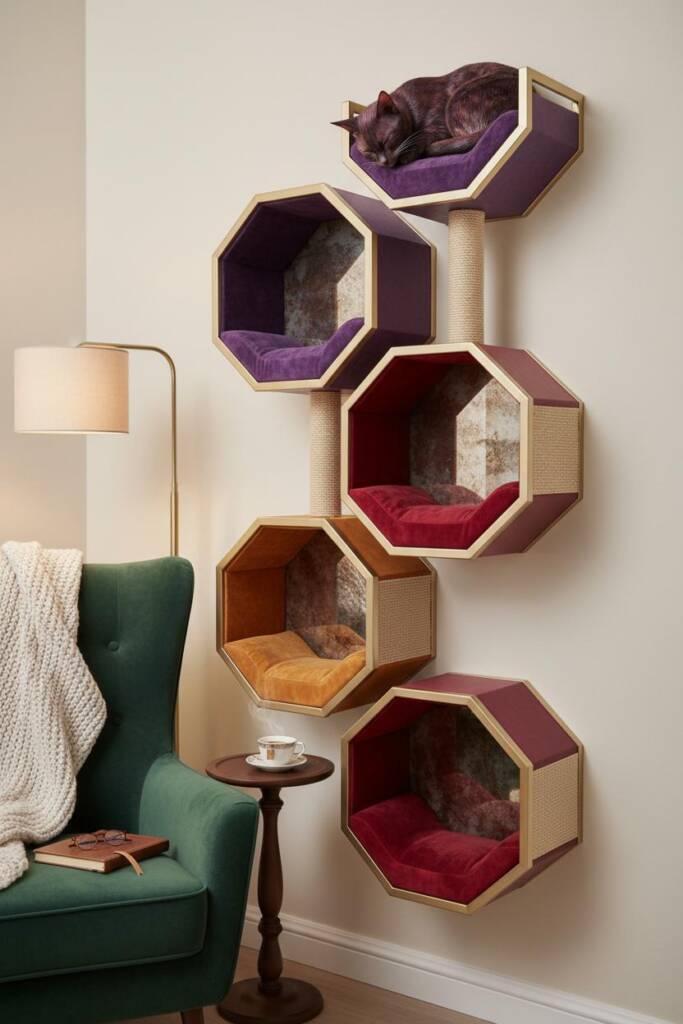
Break away from traditional floor-standing cat trees with a modular wall-mounted system of hexagonal platforms that creates a stunning geometric gallery wall. Each hexagon features antiqued mirror backing that reflects light and makes your space feel larger, topped with plush velvet cushions in jewel tones like amethyst, ruby, or topaz.
The hexagonal shape is pure Art Deco—it was everywhere from tile floors to ceiling coffers during the 1920s—and the modular nature means you can arrange them in endless configurations. Mount them in a honeycomb cluster, a diagonal ascending pattern, or scattered asymmetrically across your wall like an art installation. The mirrored backing serves a clever dual purpose: it visually doubles the impact of your design while giving your cat interesting reflections to observe (many cats are fascinated by mirrors).
Each platform needs proper weight-bearing wall anchors, but once installed, they’re incredibly stable and can support even large cats comfortably. This system works phenomenally in narrow hallways, above furniture, or in awkward wall spaces that are hard to decorate. You can start with three hexagons and add more over time, making it budget-friendly while still delivering immediate visual impact.
5. The Champagne Gold Sunburst Climber
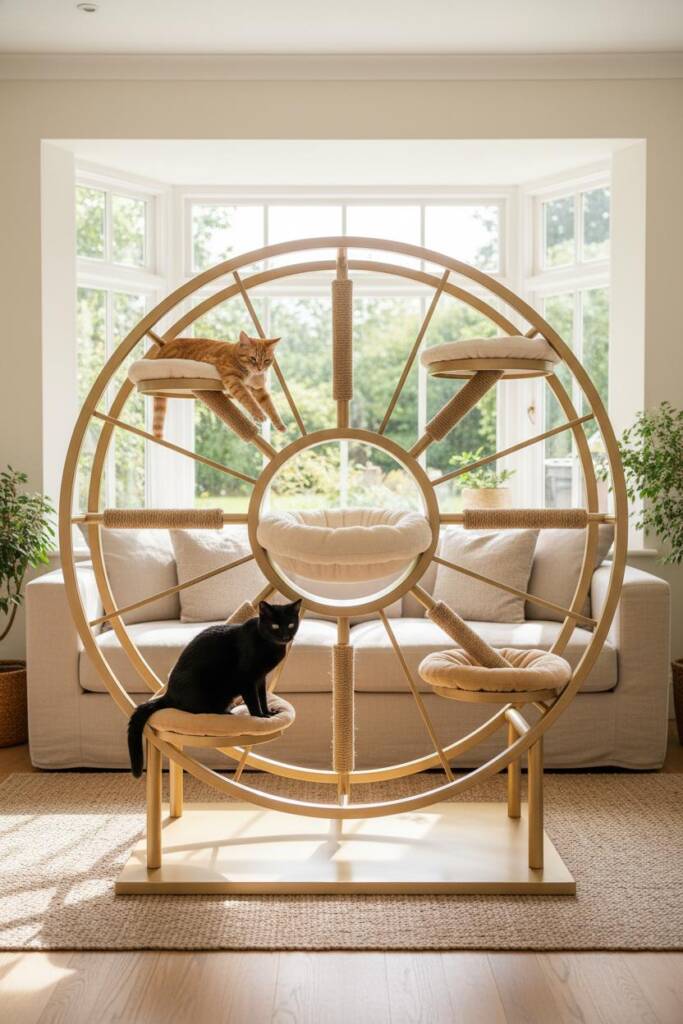
The sunburst motif is arguably the most iconic Art Deco design element, and translating it into a cat climber creates pure magic. Imagine a circular metal frame with radiating spokes extending from a central hub—like a starburst or the sun—finished in brushed champagne gold.
Between the metal spokes, plush cushioned platforms in complementary champagne, cream, or soft gold fabrics create comfortable lounging spots. This design allows cats to approach the center from any angle, giving them multiple climbing paths and the freedom to choose their route—something cats greatly prefer over single-path trees. The open framework means your cat remains visible even when they’re “hiding,” which many anxious cats actually find more comfortable than fully enclosed spaces. The metallic finish catches natural and artificial light beautifully, creating subtle shadow play on your walls throughout the day. This piec
e works exceptionally well as a room centerpiece—place it away from walls where it can be appreciated from all sides. The sunburst design also scales beautifully: create a dramatic floor-to-ceiling version for maximum impact, or a smaller tabletop version for apartments. Your cat gets 360-degree access and multiple perching options, while you get a sculptural conversation piece that commands attention.
6. Teal and Copper Deco Wave Lounge

Art Deco wasn’t all sharp angles—the movement also embraced the streamlined curves of ocean liners and luxury trains, and this flowing wave-inspired cat lounge captures that softer side perfectly. Picture undulating S-curves crafted from copper pipes that create a rhythmic, wave-like climbing structure, upholstered with rich teal velvet cushions that nestle into each curve.
The combination of teal and copper is unexpected yet sophisticated, evoking the patina of aged luxury and the glamour of ocean liner staterooms. These organic curves aren’t just beautiful—they mirror the natural stretching and curving movements cats make, creating ergonomically perfect lounging spots that support their spine. The copper pipe framework can be authentic or painted, but the warm metallic tone adds instant warmth to cooler color schemes.
This design works wonderfully as a low-profile piece, making it ideal for placing under windows where cats can bask in sunlight while maintaining the room’s sightlines. The wave formation also creates natural nooks and crannies where cats instinctively feel secure, without the boxed-in feeling of traditional cat condos. Consider how light plays across the curves throughout the day—the dimensional form creates ever-changing shadows that add visual interest even from across the room.
7. Marble-Look Cat Pedestal with Brass Details
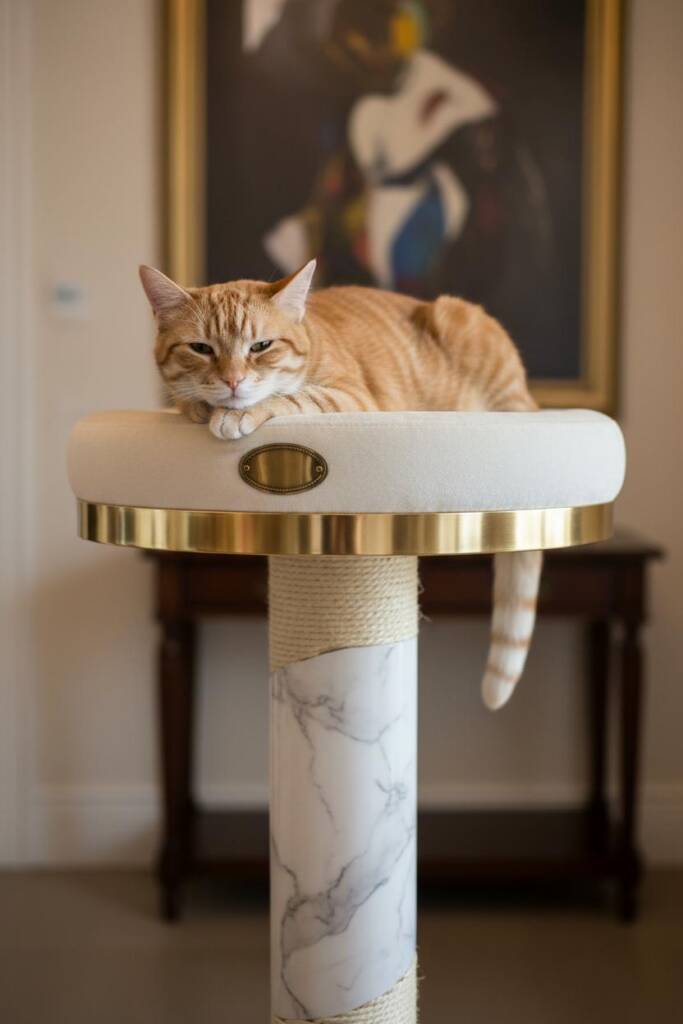
Channel ancient Roman luxury filtered through 1920s glamour with a cat pedestal that resembles a classical column topped with modern brass embellishments. The base features faux marble wrapping—think white Carrara with gray veining or dramatic black marble with gold veins—creating a weighty, substantial presence that signals “important sculpture” rather than “cat furniture.”
The top platform features polished brass edges, brass-wrapped sisal scratching posts, and perhaps a brass nameplate as if your cat were a museum exhibit. The genius of this design is its simplicity: the pedestal form takes up minimal floor space while providing impressive height, and the neutral marble tones work with virtually any color scheme. Faux marble contact paper or paint techniques make this surprisingly achievable as a DIY project, though high-end versions use actual marble composite materials.
The smooth marble surface is incredibly easy to clean—a quick wipe removes fur and dust—while maintaining that luxe appearance. This piece excels in entryways, hallways, or corners where you want vertical interest without bulk. Your cat gets an elevated throne that satisfies their desire to be above the action, while the classical-meets-deco aesthetic makes it look like an intentional design choice that predates your pet ownership.
8. The Hollywood Regency Fan-Back Throne
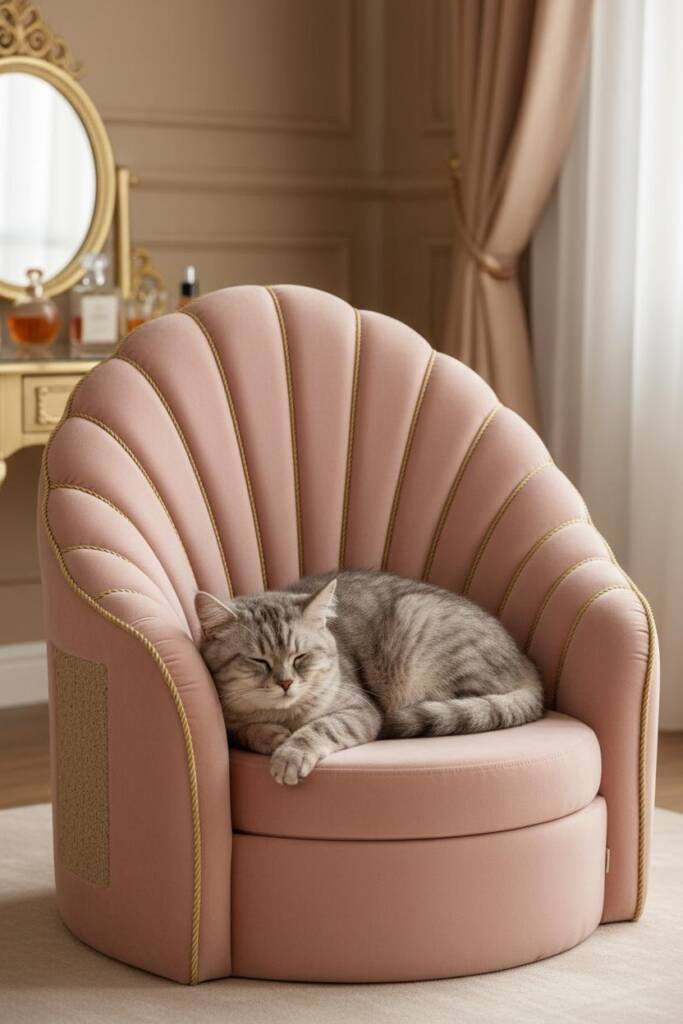
Some cats don’t just want a perch—they want a throne, and this Hollywood Regency-inspired piece delivers pure movie star energy. Picture a dramatic fan-shaped backrest rising behind a plush cushioned seat, upholstered entirely in blush pink velvet with gold cord trim outlining the fan’s radiating pleats.
This design borrows from the peacock chairs and fan-back settees that dominated 1920s boudoirs and movie sets. The high back serves multiple purposes: it creates a cozy, enclosed feeling that anxious cats crave, blocks drafts from behind, and provides the perfect backdrop for those Instagram photos of your photogenic feline. Blush pink might seem bold, but it’s actually incredibly versatile—it reads warm and inviting rather than overly feminine, especially when balanced with gold metallics.
The enclosed sides create armrests that many cats use to rest their heads while they lounge, mimicking how they’d drape themselves over your laptop. This is a lower, ground-level piece that works beautifully for senior cats or those who prefer not to climb, while still delivering maximum glamour. Place it in a bedroom corner, beside a fireplace, or even in a walk-in closet for that dressing room vibe. The fan back also cleverly hides wear and tear—cats can scratch at the back without it showing from the front viewing angle.
9. Geometric Lattice Tower in Silver and Charcoal
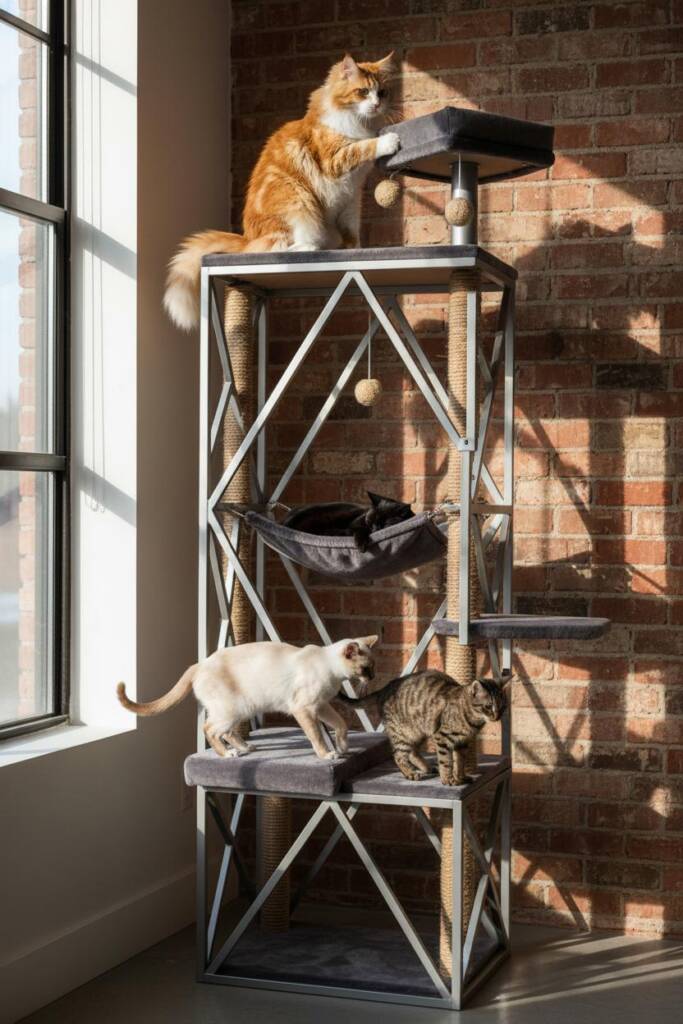
For those who love Art Deco’s architectural side but prefer a cooler, more contemporary palette, this geometric lattice tower delivers serious visual punch in sophisticated silver and charcoal. Imagine an interlocking framework of angular metal supports—think triangles, diamonds, and chevrons—creating a see-through tower structure, with charcoal gray velvet platforms suspended at various levels.
The silver metallic framework can be brushed aluminum, chrome-look paint, or powder-coated steel, giving it an industrial-chic edge that appeals to modern masculine aesthetics. This open lattice design is brilliant for multi-cat households because it doesn’t create blind spots—cats can see approaching felines from all angles, reducing territorial stress. The geometric negative space makes this substantial piece feel airy rather than bulky, and the monochromatic palette ensures it won’t compete with your existing decor.
Charcoal gray is the unsung hero of cat furniture colors: sophisticated enough for design-forward spaces, yet forgiving enough to hide the inevitable fur and wear. The angular climbing structure provides varied jumping distances and angles, keeping athletic cats mentally stimulated as they plot their routes. This tower excels in contemporary lofts, modern farmhouse spaces, or anywhere you want strong architectural presence without color commitment. The interplay of solid platforms and open framework creates fascinating shadow patterns when backlit, adding another layer of visual interest.
10. The Great Gatsby Glass and Gold Bar Cart Cat Bed
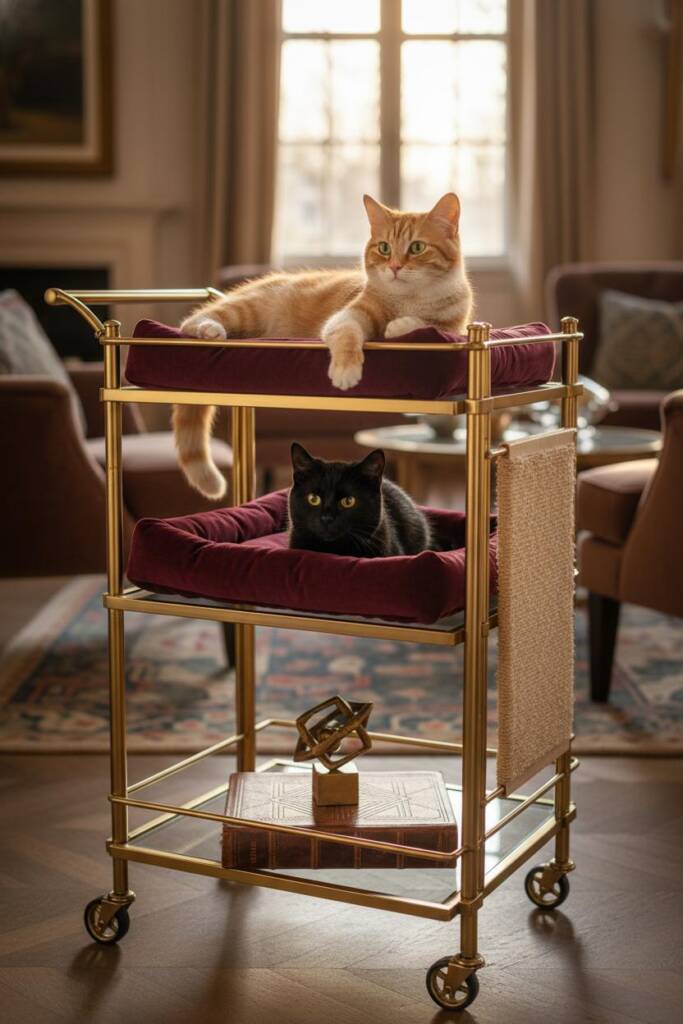
Here’s where Art Deco cat furniture gets truly creative—repurposing the iconic bar cart silhouette into a mobile cat lounging station. Picture a two or three-tiered rolling cart with a gold-finished metal frame, tempered glass shelves for easy cleaning, and plush velvet cushions on each level in deep wine, forest green, or midnight blue.
The wheels allow you to move your cat’s favorite spot around the house—next to your desk while you work, beside the sofa for movie night, or near a sunny window during the day. This design is pure 1920s cocktail party energy, and it genuinely looks like a stylish bar cart until someone notices the luxurious cat cushions. The glass shelves are practical genius: you can see if your cat is on the lower level without bending down, and they’re incredibly easy to clean and disinfect.
The open sides mean your cat never feels trapped, while the tiered structure gives them options—higher for surveying, lower for feeling secure. The cart’s relatively compact footprint makes it perfect for apartments or small spaces where traditional cat trees overwhelm. You can even style the bottom shelf with Art Deco accessories like vintage books or geometric sculptures when your cat isn’t using it, fully integrating it into your decor. The mobility factor is especially valuable for elderly cats who follow you room to room—their favorite spot can travel with them.
How to Style Your Art Deco Cat Furniture
Pairing with Your Existing Decor
Art Deco cat furniture doesn’t require a full room makeover to shine—it actually elevates whatever style you already have. In modern minimalist spaces, these geometric pieces add the visual interest and texture that stark minimalism often lacks, becoming the room’s intentional focal point.
For traditional or transitional homes, Art Deco bridges old and new beautifully; pair your velvet cat tower with oriental rugs and antique furniture for an eclectic collected-over-time feel. Even in farmhouse or cottage-style rooms, a jewel-toned Art Deco piece provides sophisticated contrast—think of it as the unexpected element that prevents “themed” decor from feeling one-note. Color coordination matters: if your room features cool tones, choose silver, sapphire, or teal Art Deco pieces; for warm spaces, lean into gold, emerald, or copper finishes.
Don’t be afraid to let your cat furniture be the boldest element in a neutral room—a statement emerald velvet tower in an all-white space creates gallery-like drama. Consider sight lines too: these sculptural pieces deserve to be seen from multiple angles, so placement near entryways or in open floor plans maximizes their impact.
Materials That Make the Difference
The magic of Art Deco style lives in its materials, and choosing quality versions ensures your cat furniture looks luxurious for years. Velvet isn’t just pretty—it’s practical for cat furniture because the dense pile resists claw snags better than loosely woven fabrics, and it naturally repels some dust and dander.
Look for performance velvets or velvet with synthetic blends that hold up to wear while maintaining that signature sheen. Brass and gold finishes come in many forms: solid brass develops a natural patina that many love, while brass-plated or gold-painted options maintain their shine with occasional polishing. For powder-coated metals, choose matte finishes in high-traffic areas as they hide scratches better than high-gloss.
When it comes to “marble” elements, laminate or contact paper versions are surprisingly convincing and far more budget-friendly, though marble composite materials offer authentic weight and coolness that cats love on hot days. Sisal remains the gold standard for scratching posts, but wrapping it in brass wire or painting the posts metallic transforms standard materials into Art Deco glamour.
Maintenance is easier than you’d think: velvet vacuums beautifully with an upholstery attachment, metallics need only occasional dusting, and most finishes wipe clean with a damp cloth. Investing in quality materials upfront means your glamorous cat furniture maintains its “wow factor” rather than looking shabby within months.
Shopping List: Essential Elements for Art Deco Cat Glamour
Ready to create your own Art Deco cat paradise? Whether you’re shopping for ready-made pieces or planning a DIY transformation of existing cat furniture, these essential elements will help you capture that 1920s luxury:
- Jewel-Toned Velvet Fabric or Cushions – The foundation of Art Deco opulence. Look for remnant fabrics in emerald, sapphire, ruby, or amethyst. Performance velvet resists stains and stands up to kneading claws. Even swapping out basic cushions for velvet transforms ordinary cat beds into glamorous lounges.
- Metallic Spray Paint in Gold, Brass, or Chrome – The fastest way to transform any cat tree. Choose specialty metallic finishes designed for furniture rather than basic craft metallics—they’re worth the extra cost for authentic-looking shine and durability. Perfect for updating scratching posts, platforms, or entire structures.
- Geometric Stencils or Adhesive Decals – Sunbursts, chevrons, hexagons, and fan shapes instantly signal Art Deco. Use stencils with metallic paint on platforms, or apply vinyl decals to smooth surfaces. Look for oversized patterns that read well from across the room rather than tiny details that get lost.
- Brass Hardware and Decorative Elements – Cabinet pulls, corner brackets, upholstery nails, and decorative medallions add authentic period detail. Scout hardware stores and vintage shops for affordable finds. Even a few well-placed brass accents elevate the entire piece.
Transform Your Space into a Feline Speakeasy
Art Deco cat furniture proves you never have to choose between loving your cat and loving your home’s aesthetic. These geometric, glamorous pieces honor both your design sensibilities and your cat’s natural behaviors—climbing, scratching, surveying, and lounging—all while looking like they belong in a luxury penthouse. The beauty of this style is its flexibility: start with one statement piece and build your collection over time, or commit fully to a cohesive Art Deco paradise.
Either way, you’re creating spaces where both you and your cat feel elevated, surrounded by beauty that celebrates the golden age of design. At Sweet Purrfections, we’re passionate about helping pet lovers and home lovers discover that these two identities don’t just coexist—they enhance each other. Your cat deserves glamour, and your home deserves to showcase the sophisticated pet parent you are. Now go forth and let your space roar with 1920s splendor.
Meet Sean, a fintech whiz with a penchant for pet purrs and blockchain buzz. After a decade of fintech feats, Sean’s tech talents leaped from ledger lines to litter lines, driven by a passion for pets and a vision for a more connected pet care community. With three critter companions as co-pilots, Sean launched this blog to share a treasury of pet-friendly tech tips and tales.


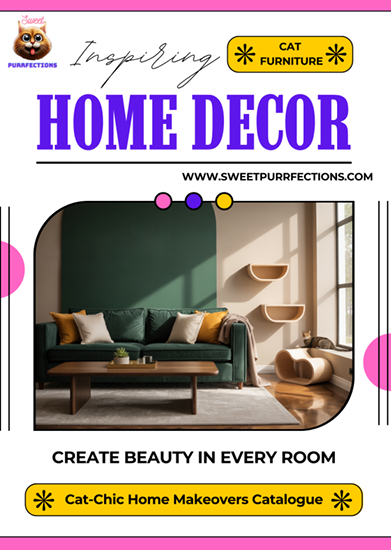
Leave a Reply